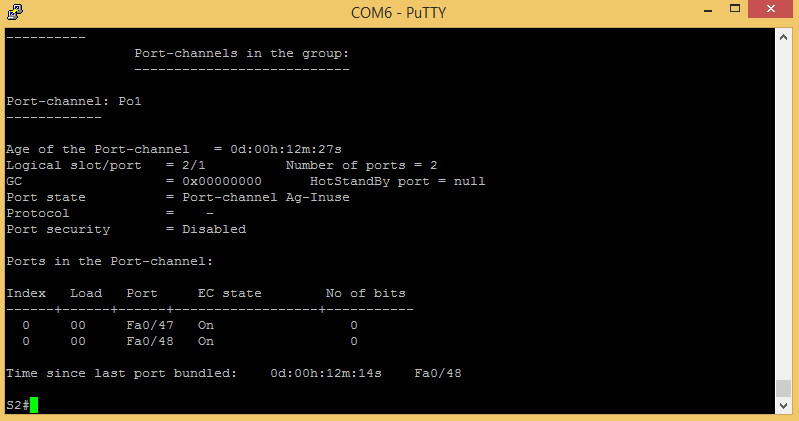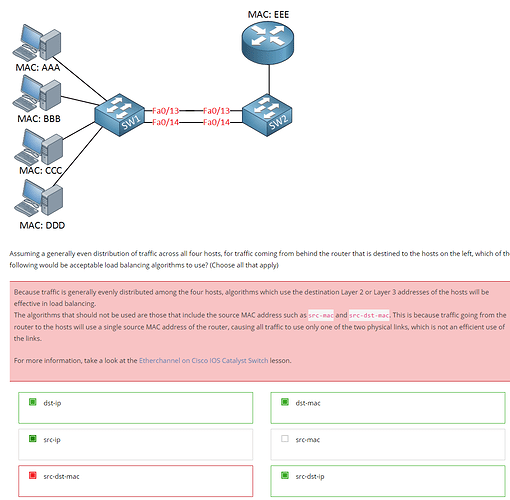Thank you! Just one quick clarification: Multiple FTP transfers happening simultaneously would be considered multiple sessions, correct?
Hello Aaron
Yes that is correct. From the client’s perspective, the source port will be different for each session. The port on the server remains the same (ports 20 for data and 21 for control). Because the ports on the client are different, even if everything else remains the same (MACs, IPs, destination port), they are considered different sessions.
I hope this has been helpful, and that you stay healthy and safe!
Laz
HI Rene,
thanks for the great post very informative, just so you know minor typo in the post ![]()
Speed has to be there same → Speed has to be the same.
would you be able to a lesson on the test etherchannel command please?
i found it very useful for being able to determine exactly which port traffic would go down and a good way to test your load balancing is actually working.
Here is an example for you using destination IP for load balancing, you can see DNS lookups from 10.1.1.1 could be load balanced, the same with traffic to other IP’s for other destinations would use other ports.
Switch#test etherchannel load-balance interface port-channel 2 ip 10.1.1.1 8.8.8.8
Would select Gi0/4 of Po2’
Switch#test etherchannel load-balance interface port-channel 2 ip 10.1.1.1 8.8.4.4
Would select Gi0/5 of Po2
Hello Matthew
Thanks for pointing out the typo, I’ll let @ReneMolenaar know to fix that. Concerning your suggestion for the addition of the test etherchannel command, go to the Member Ideas page link below where you can suggest lessons and provide feedback. You may find that others have suggested something similar, and you can add your voice too.
In the meantime, take a look at the following Cisco documentation that describes this command in more detail.
I hope this has been helpful!
Laz
Hello,
I have a question:
can we use Etherchannel between a switch and a switch stack, so each cable that’s coming from the switch will be connected to a different switch of the stack?
Hello Bilal
Yes, it is possible to create an Etherchannel connection between a switch and a switch stack so that each cable is connected to a different switch of the stack. This is called Cross-Stack Etherchannel and is actually best practice to employ whenever you create an etherchannel on a switch stack.
You can find out more information about this at the following Cisco documentation:
I hope this has been helpful!
Laz
Liz Sir!
Hello,
I did the configuration of Ether channel on real cisco switches of 2960 series and the configuration worked.
The question is here that when I want to see that which protocol I am using I mean (PAPG or LACP) it doesn’t show me please see the attached and also when I want to manually select the protocol ( PAPG or LACP) then it gives me the below error
(config-if-range)#% Interface range command failed for FastEthernet0/48
Note: I did the all commands, in order to troubleshooting to see the protocol that is PAGP or LACP but it did not show me!
With Regards
Ajmal “Ajmal Ahmadi
Hello Ajmal
When configuring Ethernchannel, if you choose the “on” mode, then you are not using any negotiation protocol. You have manually configured the etherchannel to always be on. So neither PAgP nor LACP are being used. And this is why there is no protocol displayed in your output.
I hope this has been helpful!
Laz
Which protocol we use in the industry ?
Lacp
Pagp or
Manual
.I have packet tracer mobile and few commands don’t work on it like
Show interfaces port channel 1
Show run interfaces gi0/1
Show etherchannel 1 port channel
Is there any alternate commands to it ? My laptop will come at the end of this month or next month so till that time I will use packet tracer Android
Thanks
I’m trying to visualize the diagram which is source and destination .
(1)5 hosts
(2)SW1
(3)Sw2
Hosts leave sw1 so sw1 port channel will be source for the hosts on the left .
There’s router connected to SW2 . so traffic coming from router will go to Sw2 to sw1 . so why not make sw2 into source as well ?
Load balancing method SRC Mac address .
I know answer is for sw2 is load balancing destination. Does it mean it’s destination for 5 hosts on sw1 ? Or destination for router router?
I read in previous chapters that we should use 802.1q trunk manually and should never use auto or desirable then why we are using it in the Etherchannel?
Manually aren’t supposed to be reliable ?
And switch port no negotiate can be used in etherchannel ?
Thanks
Hello Abdul
It depends. When connecting two switches together, and you are administrator in both switches, it’s a good idea to manually configure the EtherChannel to make sure it will always behave as configured. However, there are cases where you would want the negotiation to take place, especially if you are connecting a server with multiple NICs to a switch. In such cases, it’s a good idea to use LACP which is what is typically used by servers for this purpose. PAgP is a Cisco proprietary protocol that is typically used between Cisco devices, but as mentioned before, it is generally considered best practice (by some or most) to disable this and manually configure it.
Remember that load balancing algorithms are applied in each direction, and they can be different for each direction. More information on how to choose these can be found in the following post:
Dynamic Trunking Protocol (DTP) is different than EtherChannel, and has different vulnerabilities. DTP should be disabled in order to avoid a malicious user gaining access to a VLAN it should not have access to. LACP and PAgP don’t have such vulnerabilities but can move the link into an unintended state in certain circumstances.
It depends on the implementation. For servers, it is preferable to use LACP as it includes mechanisms that are useful in the event of a failure. For switch to switch connections, a manual configuration is more stable.
You can use this, but it will only configure the DTP state of the whole etherchannel bundle, and will not affect the operation of Etherchannel.
I hope this has been helpful!
Laz
Hi thanks I understand and my misconception is cleared .
My only confusion is load balancing. What I get today I look at diagram again.
Scenario1:-
(1)Host 1 ,2,3,4 Entert point is Switch Gigabit ethernet ports (port channel 1) . So it will be source port for hosts on sw1 .
(2)Sw2 is the destination for the sw1 hosts ie 1,2,3,4 . So it will be destination for sw1 hosts .
Scenario 2 : if there’s 4 hosts on sw1 and 4 hosts on sw2 so we will use load balancing src & dst on Sw1 (or only Src mac) and src & dst on SW2.
Scenario 3 : if we also want to route router traffic to sw1 then it will use src & dst on both ends of etherchannel ?
I had read all 131 messages but still I have confusion
Hello Abdul
The general rule of thumb has to do with how many devices you have on each end of the etherchannel link. Imagine the following topology:
Network A --------SW1=====echannel===== SW2 ---------Network B
For traffic from Network A to Network B, load balancing should be configured as follows:
- If Network A has many hosts and Network B has few (or one), load balancing should be configured based on source addresses (IP or MAC)
- If Network B has many hosts and Network A has few (or one), load balancing should be configured based on destination addresses (IP or MAC)
- If both Network A and Network B have many hosts load balancing can be configured using either source or destination addresses or both.
In your scenario 3, you have many hosts on both ends, even though one end also has a router. For such a scenario, you must determine what traffic patterns you will have. If most traffic of the will go to the router on the other end rather than to the other hosts, then you should only use source addressing for load balancing. If you have a lot of traffic between hosts on both ends, then you can use either source or destination, or both.
I hope this has been helpful!
Laz
Hi Laz,
how load balancing is performing here mean on host basis or frame basis?
Hello Pradyumna
Load balancing is described in detail in this section of the lesson, but is also detailed in several posts above.
In brief, there are several load balancing algorithms you can use which focus on the IP address and/or MAC addresses of both source and destination. So load balancing does not take place on a frame by frame or packet by packet basis, but on a host by host basis, based on the IP or MAC addresses of either source or destination or both.
You can find out more details at this post as well:
I hope this has been helpful!
Laz
Hey, quick question guys: With the src-dst-ip load balancing option, would I be correct in saying that both the source AND destination IP would have to match in order for multiple traffic streams to use the same etherchannel port?
Like, two streams going IP-A to IP-B and IP-A to IP-C would go on different ports, but IP-A to IP-B and IP-A to IP-B would go on the same one?
Thanks!
Hello Louis
Yes, you are correct. Keep in mind, however, that there are cases where you may have a stream from IP-A to IP-B and another from IP-A to IP-C and they both use the same physical link. For example, if you have two physical links, and 10 different src-dst-ip combinations, five of those combinations will use one link and the other five will use the other link. So you do have multiple combinations that may use the same link.
However, the same src-dst-ip combination will always use the same physical link, so yes you are correct.
I hope this has been helpful!
Laz
Hi Laz,
Thanks for the response!
I am having trouble reconciling the answer to this practice exam question:
(I hope the image is big enough to see)
I would have thought the src-dst-mac option would be ok to load balance the traffic, as while the MAC address of the source will be all the same, the MAC addresses of the destinations will be different, thus it will get load balanced based on the destination. If the traffic will all go on 1x link because it’s sourced from the same MAC, regardless of the destination MAC, then wouldn’t the src-dst-mac option effectively be the same as the src-mac option?
Thanks.
Hello Louis
You are absolutely correct. The src-dst-mac algorithm would indeed provide a good load balancing algorithm since the destination MAC would not be the same in each instance, allowing the efficient use of multiple EtherChannel links. I have gone in and corrected this question and the explanation.
Thanks for pointing that out!
Laz
I have the following
portchannel 10
switchport mode access
switchport access vlan 10
int range g1/0/1 - 2
switchport mode access
switchport access vlan 10
channel-group 10 mode on
Problem is one switchport goes green the other remains solid amber.
My reasoning for switchport mode access is, all hosted machines exist in the same subnet. Is thre a good reason to go to a trunk?

